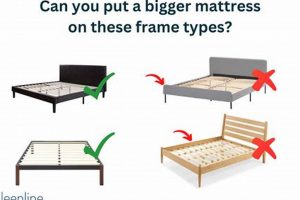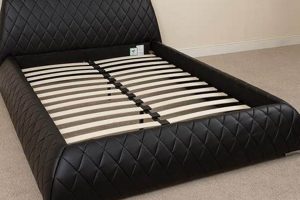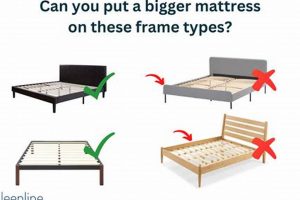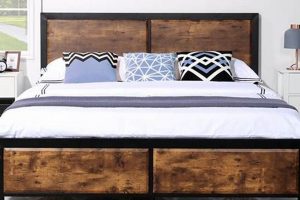The question of whether a smaller mattress is compatible with a larger bed frame is a common concern when considering furniture purchases or rearrangements. A full-size mattress, with its specific dimensions, is designed to fit snugly within a bed frame also designated as full-size. Conversely, a queen-size bed frame is constructed to accommodate a queen-size mattress, which is significantly larger in both width and length.
Understanding the compatibility of mattress and frame sizes is important to ensure proper support, comfort, and aesthetics. Using an incorrectly sized mattress within a bed frame can lead to instability, premature wear and tear on the mattress, and an aesthetically unpleasing gap. The correct pairing of frame and mattress contributes to the longevity of both items and optimal sleep quality.
Given the dimensional differences, this discussion will explore the ramifications of placing a full-size mattress within a queen-size bed frame, outlining potential issues and alternative solutions. The analysis will address the practical implications and provide guidance on how to manage the size discrepancy effectively.
When addressing the question of whether a smaller mattress fits within a larger frame, several considerations arise to ensure stability and comfort.
Tip 1: Assess the Size Difference: Quantify the exact dimensional difference between the full-size mattress and the queen-size frame. This measurement will inform the extent of the gap that needs to be addressed.
Tip 2: Utilize Filler Materials: Employ materials like foam inserts, wood shims, or rolled blankets to fill the gap between the mattress and the frame. Ensure the filler is evenly distributed to provide uniform support.
Tip 3: Consider a Bunkie Board: A bunkie board, placed beneath the full-size mattress, can elevate its height to better align with the frame’s headboard and footboard. This option primarily addresses aesthetic concerns rather than structural integrity.
Tip 4: Centralize the Mattress: Position the full-size mattress in the center of the queen-size frame. While gaps will remain on either side, centering the mattress can promote a more balanced weight distribution.
Tip 5: Employ Side Rails with Slats: Ensure the queen-size frame has adequate side rails and slats to support the smaller mattress. Additional slats may be needed to prevent sagging or uneven support.
Tip 6: Evaluate the Intended Use: Determine the primary use of the bed. If it is for occasional use in a guest room, the size discrepancy may be less critical than if it is for daily use.
Tip 7: Secure the Mattress: Implement measures to prevent the mattress from shifting within the larger frame. This can be achieved with non-slip pads or strategically placed restraints.
Careful assessment and mitigation of the size difference is crucial for ensuring both comfort and the longevity of the mattress. Addressing the dimensional disparity contributes to a safer and more supportive sleep environment.
The next section will explore alternatives if the aforementioned tips prove insufficient or impractical for long-term use.
1. Dimensional Differences
The fundamental issue when attempting to place a full-size mattress within a queen-size bed frame stems from the dimensional differences between the two. A full-size mattress typically measures approximately 54 inches wide and 75 inches long, while a queen-size mattress is significantly larger, measuring around 60 inches wide and 80 inches long. This difference in dimensionsspecifically, a 6-inch gap in width and a 5-inch gap in lengthcreates a considerable void when a full mattress is placed within a queen frame. This void is not merely an aesthetic concern; it directly affects the structural integrity and support provided by the bed frame. The intended design of a bed frame relies on a mattress that fully occupies the space to distribute weight evenly and prevent shifting or sagging.
The consequences of ignoring these dimensional discrepancies range from minor discomfort to potential safety hazards. For example, a significant gap between the mattress and the side rails of the frame can lead to the mattress shifting unexpectedly during sleep, potentially causing a sleeper to roll off the bed. Furthermore, the lack of proper support can accelerate the wear and tear on the mattress itself, leading to premature sagging or unevenness. Consider a scenario where the bed is frequently used by multiple individuals; the stress on a full-size mattress unsupported within a queen-size frame will be amplified, leading to instability and a reduced lifespan for both the mattress and the frame.
In conclusion, the dimensional differences between a full-size mattress and a queen-size bed frame are not trivial. They directly impact the stability, support, and longevity of the sleep system. While makeshift solutions may temporarily address the visible gaps, they rarely provide a durable or effective substitute for a correctly sized mattress. Understanding these dimensional constraints is crucial for ensuring a safe, comfortable, and structurally sound sleep environment. Choosing the appropriate mattress size to match the bed frame remains the optimal solution.
2. Support Deficiency
The problem of support deficiency is a direct consequence of placing a full-size mattress within a queen-size bed frame. A correctly sized mattress is designed to distribute weight evenly across the frame’s support structure. When a mattress is smaller than the frame, this distribution is compromised, leading to areas of inadequate support and potential structural issues.
- Uneven Weight Distribution
A full-size mattress in a queen frame creates concentrated pressure points. Areas of the frame without mattress coverage receive less support, potentially leading to sagging or damage to the frame over time. This uneven weight distribution can also result in discomfort for the sleeper, as the mattress may tilt or shift towards the unsupported edges.
- Compromised Edge Support
Mattress edge support is crucial for providing a stable sleeping surface and preventing roll-off. A full-size mattress in a queen frame lacks the necessary edge support along the sides, as the mattress does not fully extend to the frame’s edges. This can result in a feeling of instability when sitting or lying near the edge of the bed, reducing the usable sleeping surface.
- Increased Mattress Wear
The lack of full support can accelerate wear and tear on the mattress. Areas of the mattress that are not properly supported may experience premature sagging, compression, or deformation. This not only reduces the comfort and lifespan of the mattress but can also void any warranties that require proper frame support.
- Potential for Frame Damage
The concentrated weight distribution and lack of full support can also damage the bed frame. Slats may break or warp under increased pressure, and the frame’s joints may weaken or become unstable. Over time, this can lead to structural failure of the bed frame, requiring costly repairs or replacement.
The facets discussed underscore the crucial need for correctly matched mattress and frame sizes. Using a full-size mattress in a queen-size frame inevitably leads to support deficiency, with detrimental consequences for both the mattress, the frame, and ultimately, the sleep experience. While temporary solutions may mitigate some of the issues, they do not address the underlying problem of mismatched dimensions and compromised support. Therefore, to ensure proper support, longevity, and safety, it is essential to use a mattress that is specifically sized to fit the bed frame.
3. Aesthetic Concerns
The visual appeal of bedroom furnishings is a significant consideration for many individuals. Placing a full-size mattress within a queen-size bed frame introduces a number of aesthetic discrepancies that can detract from the overall visual harmony of the room. These discrepancies are often immediately noticeable and can create a sense of imbalance or incompleteness in the bedroom decor.
- Visible Gaps
The most prominent aesthetic issue is the presence of visible gaps between the mattress and the bed frame. These gaps, typically several inches wide on either side of the mattress and at the head or foot of the bed, create an unfinished look. Instead of a cohesive unit, the bed appears as two separate components that do not quite fit together. The visual void can be particularly jarring if the bed frame has decorative elements or a prominent design, as these features are not properly complemented or accentuated by the smaller mattress.
- Disproportionate Headboard and Footboard
Many bed frames feature a headboard and/or footboard that are designed to visually balance with the size of the mattress. When a full-size mattress is used in a queen-size frame, the headboard and footboard can appear disproportionately large relative to the mattress. This imbalance can disrupt the visual flow of the room and create an awkward or ungainly appearance. The headboard, in particular, may seem overwhelming and out of scale with the smaller mattress.
- Unfilled Space
A queen-size bed frame typically occupies a significant amount of floor space in a bedroom. When a full-size mattress is placed within it, the unfilled space around the mattress can create a sense of emptiness or underutilization of the available area. This can be particularly noticeable in smaller bedrooms, where the bed is often the focal point of the room. The unused space may also attract clutter or become a dumping ground for miscellaneous items, further detracting from the overall aesthetic appeal.
- Color and Texture Clashes
The aesthetic concerns extend beyond just the physical dimensions of the mattress and frame. The colors and textures of the mattress, bedding, and frame also play a role in the overall visual appeal. The visible gaps expose more of the bed frame’s material, and if that material clashes with the colors or patterns of the mattress or bedding, it can create a visually jarring effect. For example, a dark-colored bed frame with a light-colored mattress and bedding may accentuate the gaps and create an undesirable contrast.
In summary, the use of a full-size mattress in a queen-size bed frame introduces a number of aesthetic challenges that can negatively impact the overall visual appeal of the bedroom. From the visible gaps and disproportionate headboard to the unfilled space and potential color clashes, these discrepancies detract from the sense of harmony and balance that is essential for a comfortable and visually pleasing sleep environment. While addressing structural and comfort issues may require more attention, it is necessary to recognize these aesthetic impacts as a combined issue from placing a full-size mattress in a queen-size bed frame.
4. Filler Options
When a full-size mattress is used in a queen-size bed frame, a dimensional disparity arises, necessitating the consideration of filler options to mitigate the resulting gaps. These options aim to provide support, prevent mattress shifting, and improve the overall aesthetic.
- Foam Inserts
Foam inserts, typically composed of high-density polyurethane or memory foam, can be cut to size and placed within the gaps between the mattress and the frame. These inserts provide supplemental support, preventing the mattress from sagging or shifting. For instance, if a 3-inch gap exists on either side, custom-cut foam pieces can fill this void, creating a more uniform surface. However, the long-term durability and compression resistance of the foam must be considered to avoid uneven support over time. Improper density will cause the foam to compress quickly and leave a significant gap.
- Wood Shims or Slats
Wood shims or additional slats can be added to the bed frame’s support structure to provide a more stable base for the smaller mattress. These modifications can help distribute weight more evenly and prevent the mattress from sinking into the frame. A practical example involves adding wood slats spaced evenly across the frame to reduce the span between supports. Proper placement and secure attachment are crucial to avoid creating new points of instability or compromising the frame’s integrity. The wood should be strong enough to hold the weight of the mattress, as well.
- Rolled Blankets or Towels
In less permanent scenarios, rolled blankets or towels can serve as temporary fillers to minimize gaps. These items can be strategically placed along the sides or ends of the mattress to provide a degree of support and prevent shifting. For instance, tightly rolled towels can fill smaller gaps along the sides of the mattress. While cost-effective and readily available, this solution is generally considered a short-term fix due to its limited durability and potential for shifting over time. This is a very temporary fix, as this will break down over time and with use.
- Fabric Gap Fillers
Commercially available fabric gap fillers, often constructed from durable materials and designed to blend with bedding, offer a more aesthetically pleasing solution. These fillers are specifically designed to fit within the gaps and provide a more uniform appearance. An example would be a long, bolster-like cushion that runs along the side of the mattress, filling the gap and providing additional support for those sitting on the edge of the bed. While visually appealing, the level of support provided may vary depending on the filler’s construction and materials. This is a great short term solution.
In conclusion, while filler options can provide a temporary or partial solution to the problem of fitting a full-size mattress in a queen-size bed frame, they do not fully replicate the support and stability of a correctly sized mattress. The effectiveness of these options depends on factors such as the size of the gap, the materials used, and the intended use of the bed. Opting for a mattress that corresponds to the frame’s dimensions remains the optimal approach for ensuring long-term comfort, support, and aesthetic harmony.
5. Frame Modification
The question of whether a queen bed frame can accommodate a full mattress frequently leads to the consideration of frame modification as a potential solution. The dimensional discrepancy between the two mattress sizes a queen typically measuring 60 inches wide by 80 inches long, and a full measuring 54 inches wide by 75 inches long necessitates addressing the resulting gaps to ensure stability and support. Frame modification, in this context, refers to alterations made to the queen-size bed frame to better secure and support the smaller, full-size mattress. This might involve adding additional slats, adjusting side rails, or incorporating custom-built supports designed to fill the void and prevent mattress shifting.
The importance of frame modification stems from the inherent risks associated with using an improperly sized mattress within a larger frame. Without modification, the full mattress may lack adequate edge support, leading to a feeling of instability and increasing the risk of rolling off the bed. Furthermore, the uneven weight distribution can cause premature wear and tear on both the mattress and the frame, potentially shortening their lifespans. For instance, adding plywood support within the frame could provide a base, which can better support a full-size mattress. Frame modification, thus, aims to mitigate these risks by creating a more secure and stable sleeping surface. However, it is important to be aware of potential safety considerations. Any frame adjustments must not compromise the structural integrity of the frame itself, and all modifications should be carried out with appropriate tools and expertise. This might also void any warranties on the frame.
In conclusion, while frame modification can offer a viable solution for adapting a queen bed frame to accommodate a full mattress, it is not without its challenges. The success of such modifications depends on careful planning, precise execution, and a thorough understanding of the frame’s structural limitations. Furthermore, the modifications should prioritize safety and stability to ensure a comfortable and long-lasting sleep experience. Ultimately, selecting the correctly sized mattress for the frame remains the optimal approach, but frame modification can serve as a temporary or cost-effective alternative when necessary.
6. Practicality Limitations
The attempt to fit a full-size mattress into a queen-size bed frame, while seemingly a simple space-saving measure, is constrained by several practicality limitations. These limitations extend beyond the mere dimensional discrepancy and impact functionality, comfort, and safety.
- Support System Compromise
A queen-size frame’s support system is designed for a queen-size mattress’s specific weight distribution. Placing a smaller, full-size mattress disrupts this design, leading to uneven support and potential sagging. Example: Slats spaced for a queen mattress may have excessive gaps for a full, causing it to dip in areas. This undermines the mattress’s integrity and can lead to discomfort or back problems for the sleeper.
- Aesthetic Disparity
The visual gap between the mattress and frame impacts the overall aesthetic. While fillers can address some of this, they are often temporary and visually imperfect solutions. Example: A decorative queen-size headboard looks disproportionate with a smaller mattress, creating an unbalanced appearance. This is significant in guest rooms or master suites where visual appeal is valued.
- Safety Concerns
The instability introduced by an ill-fitting mattress can create safety hazards. The mattress can shift unexpectedly, particularly during sleep, increasing the risk of falls. Example: A child moving around on the bed could easily slip into the gap between the mattress and frame, potentially leading to injury. This is a critical consideration, particularly in households with children or elderly individuals.
- Long-Term Cost Implications
While initially appearing cost-effective (using an existing mattress), the long-term effects of using an improperly sized mattress can lead to increased expenses. The mattress and frame may wear out prematurely due to the stress caused by uneven weight distribution. Example: Sagging or compressed sections of the mattress may necessitate earlier replacement, offsetting any initial savings. Furthermore, the frame itself may require repairs or replacement due to the imbalanced support.
These practicality limitations demonstrate that, while technically possible, fitting a full-size mattress into a queen-size bed frame is far from ideal. The compromises in support, aesthetics, safety, and long-term cost-effectiveness render this arrangement impractical for regular or long-term use. Selecting a mattress and frame of matching sizes remains the optimal solution for ensuring comfort, safety, and longevity of both components.
Frequently Asked Questions
This section addresses common inquiries regarding the compatibility of queen-size bed frames with full-size mattresses, providing clarity on potential issues and limitations.
Question 1: Is it physically possible to place a full-size mattress on a queen-size bed frame?
Yes, it is physically possible. A full-size mattress can be placed on a queen-size bed frame. However, significant gaps will exist due to the dimensional differences between the two.
Question 2: What are the primary concerns associated with using a full-size mattress on a queen-size frame?
The primary concerns include inadequate support for the mattress, uneven weight distribution, potential damage to both the mattress and frame, aesthetic issues due to visible gaps, and safety hazards arising from mattress shifting.
Question 3: Can filler materials effectively address the gaps created when using a smaller mattress on a larger frame?
Filler materials such as foam inserts or rolled blankets can mitigate some of the issues, such as mattress shifting and visual gaps. However, they rarely provide the same level of support and stability as a correctly sized mattress.
Question 4: Does using a full-size mattress on a queen-size frame void any warranties on either the mattress or the frame?
It is possible. Many mattress and frame warranties specify that the products must be used with appropriately sized companions to ensure proper support. Using a mismatched size could void the warranty.
Question 5: Are there any safety considerations when using a smaller mattress on a larger frame?
Yes, the increased risk of the mattress shifting or a person falling into the gaps between the mattress and frame presents a safety hazard, particularly for children or elderly individuals.
Question 6: Is modifying a queen-size bed frame to better fit a full-size mattress a recommended solution?
Modifying the frame is a possible solution, but requires structural knowledge and expertise. Improper modifications can compromise the frame’s integrity and potentially create new safety hazards. Consulting a professional is advisable.
In summary, while technically feasible, the practice of using a full-size mattress on a queen-size bed frame is generally discouraged due to potential compromises in support, safety, aesthetics, and warranty coverage. A correctly sized mattress is recommended.
The next section will summarize the core points discussed in this examination.
Concluding Assessment of Mattress and Frame Compatibility
The preceding analysis has thoroughly examined the question of whether a smaller mattress is suitable for a larger frame. A primary issue, stemming from dimensional disparities, introduces structural instability and compromises the support system’s integrity. Potential solutions, such as employing filler materials or frame modifications, offer only partial remediation. Aesthetic discrepancies remain, impacting the visual coherence of the sleep environment. Furthermore, safety concerns arise due to the risk of mattress shifting and potential injury. Warranties are subject to nullification, and long-term cost implications may negate any initial savings. Thus, the practice lacks comprehensive suitability.
Considering these factors, the ultimate conclusion necessitates a decisive course of action. Selecting appropriately sized components is paramount to ensure optimal comfort, safety, and longevity. While inventive adaptations may offer temporary workarounds, such measures remain inadequate substitutes for the inherent stability and designed compatibility of matching mattress and frame dimensions. Prudent decision-making should prioritize long-term benefits over short-term expediency, fostering a sleep environment that promotes well-being and structural integrity. To summarize, can a queen bed frame fit a full mattress? While possible, it is not advisable.


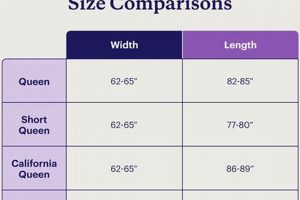
![Best Queen Size Bed Frame with Mattress [Deals] Organic & Natural Mattress Buyer’s Guide: Non-Toxic Sleep Solutions Best Queen Size Bed Frame with Mattress [Deals] | Organic & Natural Mattress Buyer’s Guide: Non-Toxic Sleep Solutions](https://mattressworldpa.com/wp-content/uploads/2025/07/th-3082-300x200.jpg)
